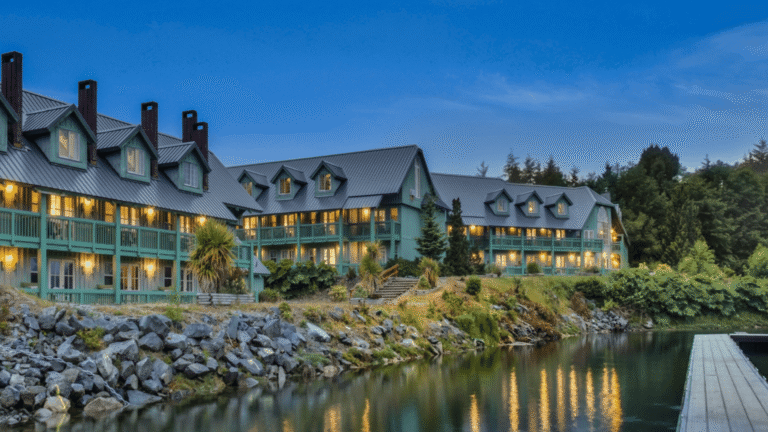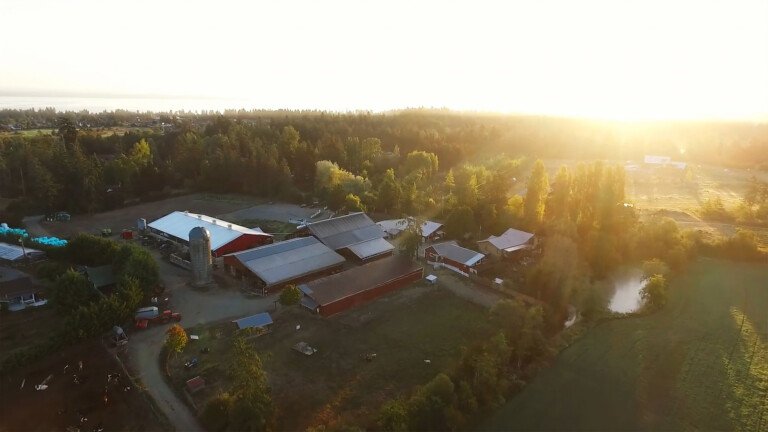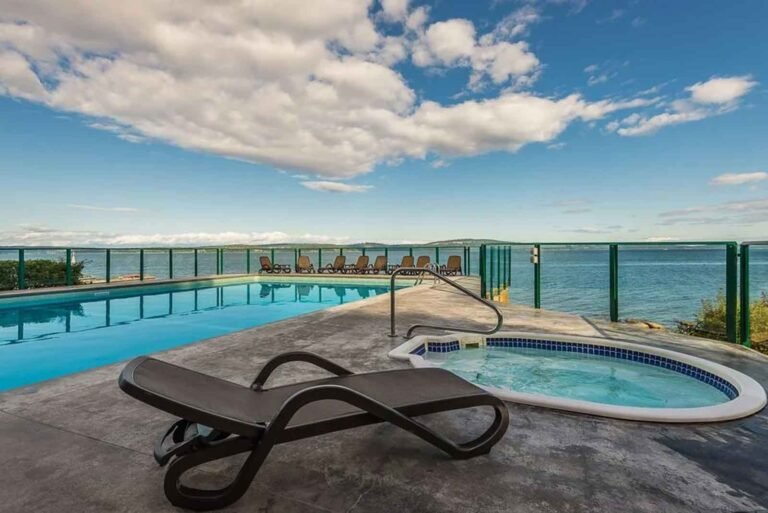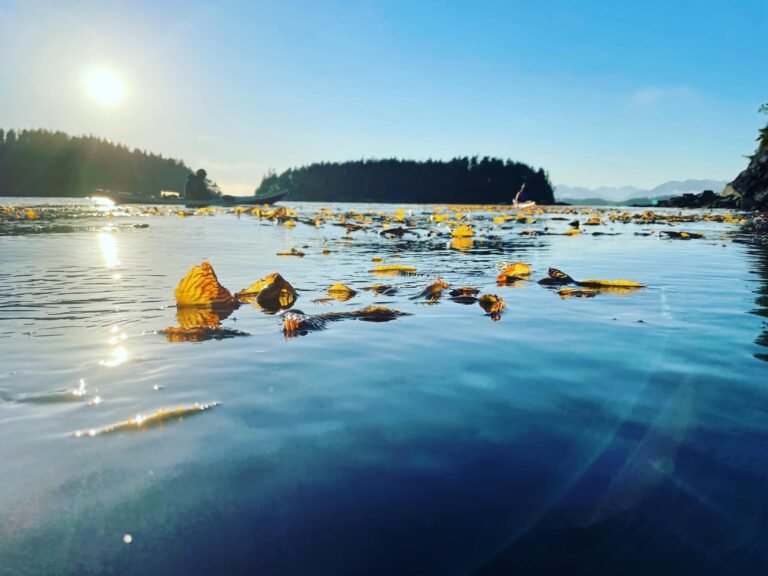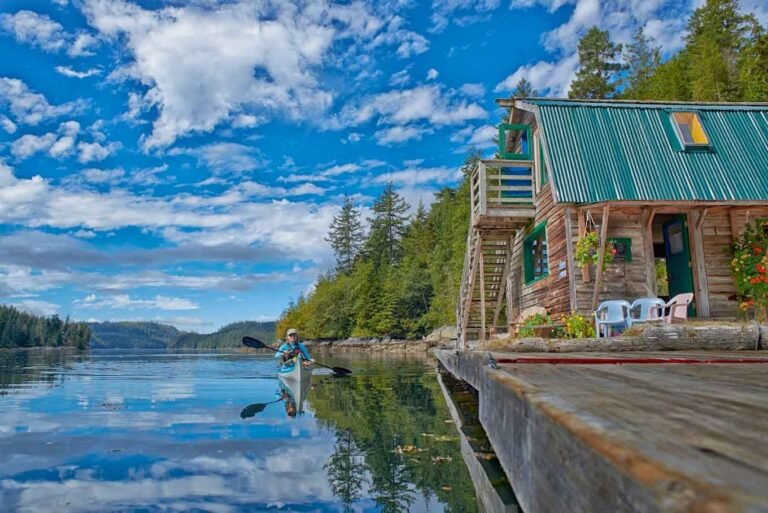Considered Alaska’s most beautiful seaside town, the historic and scenic community of Sitka is situated on Baranof Island, nestled between forested mountains and the great Pacific Ocean, on the outer waters of Alaska’s Inside Passage.
Sitka’s past is a unique blend of Tlingit culture and Russian history. The Kiksadi Clan of the Tlingit Indians had lived in and around Sitka centuries before the Russians or Americans set foot on the island’s rocky shores. Choosing the seaward side of the island they named Shee, the Tlingits called their settlement Shee Atika, meaning “people on the outside of Shee”. The name Sitka is merely a contraction.
The Tlingits thrived undisturbed on their island paradise until 1799, when the Russians arrived. It wasn’t long before Alexander Baranof, manager of the Russian-American Company, established a fort a few miles North of the present day Sitka. The Tlingits grew immediately hostile, acknowledging that submission to the Russians meant allegiance to the Tzar and slave labor to the fur trade company. Their suspicions turned to violence, when the Tlingits finally attacked the Russian outpost in 1802, killing nearly all of the Russians and their Aleut slaves.
Two years later Baranof retaliated. For six days, the island Natives fought gallantly, but were out-gunned and exited silently into the night. The Russians renamed the settlement New Archangel. Russian Orthodox Church clergy soon took up residency and fortress-like structures systematically replaced clan houses atop a shoreside hill, a site later known as Castle Hill.
The fur-trade flourished, and the Russian-American Company became the most profitable fur trader in the world. By mid-century, however, overhunting had diminished the number of sea otters, and thus the Russians’ interest in the new world. In 1867, the Russians sold Alaska to the United States for $7.2 million (2 cents per acre) with a transfer ceremony that took place in Sitka on 18 October 1867.
Today, Sitka offers a combination of Native culture, Russian history, and Alaskan wilderness, which provides visitors with a diverse and unequaled travel experience. Visitors can explore the myriad of islands and bays of Sitka Sound and beyond in one of Sitka’s comfortable tour boats, and guided sea kayak tours paddle throughout remote pristine bays. Narrated land tours take you to most of the major historical sights in the surrounding area, giving you a historical and local perspective of spectacular Sitka by the Sea. Sitka is home to twenty four attractions listed on the National Register of Historic Places, seven of which are National Historic Landmarks. The downtown area is centrally located and most points of interest are within walking distance of one another.
Population: 8,900
Location: Sitka is located on Baranof Island on the outer waters of Alaska’s Inside Passage. Like most Southeast Alaska communities, Sitka is accessible only by air and sea. Sitka enjoys daily jet service by Alaska Airlines from hubs such as Anchorage and Seattle. The flying distance from Sitka to the state capital of Juneau is 96 miles (154 kms).
The Alaska Marine Highway ferries provide year-round service for passengers and vehicles. Ferry travel times are 9 hours from Juneau to Sitka (5-6 hours by fast ferry), 10 hours from Ketchikan to Sitka, and 36 hours between Ketchikan and Bellingham in Washington. Sitka is also a popular port of call for most cruise lines that sail the Inside Passage.
Wildlife adds to Sitka’s natural beauty. The mild climate, rich habitat, and relatively low human population make Sitka one of the best places to view wildlife in Alaska. Nearby waters are a popular feeding ground for humpback whales in the late fall and early spring. Summertime provides a wonderful opportunity to view tufted puffins and other sea birds at St. Lazaria National Wildlife Refuge at the mouth of Sitka Sound (part of the Alaska Maritime National Wildlife Refuge). While out on the ocean, you may also spot sea otters, sea lions, whales and other marine wildlife.
Sitka lies at the heart of the largest temperate rain forest in the world, the Tongass National Forest, which covers most of Southeast Alaska, surrounding the famous Inside Passage. It offers unique chances to view eagles, bears, spawning salmon, and the breathtaking vistas of “wild” Alaska. You can take a sled-dog ride on a glacier, hike boardwalk trails, fish in streams or the Pacific Ocean, or just kick back and relax at one of over 150 rustic cabins scattered at remote lakes and seaside locations from Humpback Lake south of Ketchikan to Situk Lake north of Yakutat.
Outdoor Activities: Enjoy the fresh outdoors on well-marked mountain trails. Take to the water for a picturesque boat trip or kayaking adventure among nearby islands, or charter a boat to nearby fishing grounds to fish for world-class salmon and halibut.
ANB Hall, the Alaska Native Brotherhood building, is a registered National Historic Landmark built in 1914. Located on Katlian Street in the heart of the traditional Tlingit village, it serves as an Alaska Native community center.
Sitka Pioneer’s Home is a state home for elderly Alaskans, built in 1934 on the old Russian Parade Ground. The pioneers welcome visitors, and handicrafts made by the residents are sold in the gift shop located on the first floor. The 13-1/2 foot bronze statue standing in front of the Pioneer’s Home was made by Alonzo Victor Lewis and was dedicated on Alaska Day 1949. The model was a real pioneer, William “Skagway Bill” Fonda.
Princess Maksoutoff’s Grave is located behind the Pioneer’s Home in the Lutheran cemetery. Princess Maksoutoff was the wife of Alaska’s last Russian governor, Dimitrii Maksoutoff.
The Russian Block House behind the Pioneer’s Home on Katlian Street is a replica of the block house that separated Russian and Tlingit sections of Sitka after the Tlingits moved back into the area 20 years following the 1804 battle.
Mariner’s Wall at ANB Harbor has 2,000 inscriptions on the brick wall, representing the rich maritime history of Southeast Alaska, and a special memorial to mariners.
Totem Square contains a Russian cannon and three anchors recovered from the Sitka vicinity, probably lost by early British or American explorers. The totem pole displays the double-headed eagle of Sitka’s Russian heritage.
Sheet’ka Kwaan Naa Kahidi Tribal Community House on Katlian Street next to the Pioneer’s Home is constructed on a site that once housed the Indian Government School. The Community House has the largest hand-carved house screen (“Lovebirds”) in Southeast Alaska, and offers Native dance performances by the Sheet’ka Kwaan Naa Kahidi Native Dancers in full regalia, story telling, cultural events, and a small gift shop with authentic Native artwork.
Castle Hill (Baranof Castle Site) was an early stronghold of the Kiksadi clan. Later a succession of Russian buildings were erected on the site. The last one, known as “Baranof’s Castle”, was erected in 1837, and was the site of the transfer of Alaska to the United States on October 18, 1867. Baranof Castle was destroyed in a fire in 1898. Alaska Day is still celebrated on October 18th.
Building 29 (The Log Cache) on Lincoln Street, also known as the Tilson Building, is one of the few structures surviving from the Russian era of Alaska History. Built in 1835, it is listed with the National Historic Landmarks. Spruce logs, sawdust insulation system and heavy squared beams support the structure.
Saint Michael’s Cathedral houses an important collection of Russian Orthodox art and church treasures. Built in 1844-48, it was totally destroyed by fire in January 1966. Many of the icons and religious objects were salvaged and are in the rebuilt structure.
Sitka Lutheran Church on the site of the first Lutheran Church on the West coast of North America, contains original artifacts from the original 1843 Finnish Lutheran Church (1844 Kessler organ, chandelier, pulpit and communion rail). Located on Lincoln Street in the heart of downtown Sitka.
All elements of Sitka’s history converge at the Isabel Miller Museum. Packed with displays, photographs and artifacts from Sitka’s Tlingit, Russian and American history, the museum is a worthwhile first stop. It provides a perspective for almost everything else the traveller will do and see in Sitka.
The Russian Bishop’s House is the oldest intact Russian building in Sitka, built in 1842 by the Russian American Company as a residence for the Bishop of the Orthodox Church. Bishop Innocent (Ivan Veniaminov) was its first resident. The building has been restored to the 1850s historic period when it functioned as a school, Bishop’s residence, and a chapel.
As Sitka was the capital of Alaska in 1895, it was chosen as the “See City” by Bishop Rowe. In 1899 the first service was held in St. Peter’s by the Sea Episcopal Church, chartered as Alaska’s Pro Cathedral in 1901. Located directly behind the church is the Bishop’s residence, built in 1905 by Bishop Rowe and referred to as the “See House”. The church continues to be used by many as a place of quiet and prayer, and a place of meeting for community organizations. According to legend, Joseph of Arimathea’s staff took root and blossomed. In April of 1999, St. Peters’ by the Sea received the 3rd planting from this Holy Thorn of Glastonbury.
The Sheldon Jackson Museum is home to one of the oldest native culture collections in Alaska, collected between 1880 and 1900 by Dr. Sheldon Jackson, General Agent of Education. Erected in 1895, the present building was the first concrete building in Alaska.
Visit the Sheldon Jackson College Aquariam and Hatchery and experience the spectacular diversity of the many amazing creatures that thrive in the waters surrounding Sitka. Feel the spiny skin of a star fish, the soft tentacles of a sea anemone, and the coarse shell of an abalone as your hands roam through the three large touch tanks. View the feeding of four species of salmon in the nation’s only on-site college run hatchery.
The 107-acre Sitka National Historic Park preserves the site of a Tlingit Indian Fort and interprets the battle fought between the Russians and the Tlingits in 1804. A fine collection of Haida and Tlingit totem poles were moved here from the Louisiana Exposition in St. Louis in 1904. The museum contains an exhibit of Tlingit and Russian artifacts, and a totem carved by a local carver and raised in April, 1996. A free, self-guided oceanside trail leads past several totems to the site of the Tlingit fort.
A pioneering wildlife project, the Alaska Raptor Center has for years proven that dedicated volunteer effort and innovative veterinary medicine can make a life-or-death difference on Alaska’s raptors (birds of prey). The Center’s goal is to release all rehabilitated birds into the wild, but those that never recover flight remain housed at the Center’s outdoor display.
Whale Park provides an opportunity to view wildlife (from the boardwalk), including humpback whales in the late fall and early spring months. Although whales can be seen year-round while out on the ocean, humpbacks practically park themselves in front of Sitka’s harbor in the fall and early winter. Situated on a high overlook just six miles from downtown, Whale Park offers visitors a great vantage to viewing the gentle giants of the Pacific. In early November the Sitka Whalefest celebrates Sitka’s marine life with special activities and information seminars from renowned marine biologists. The park is located about 6 miles south of downtown Sitka and has a small sheltered picnic area and free viewing scopes. A hydro phone is located in the main shelter area to listen to the “songs” of the humpback whales.
Japonski Island was the World War 2 headquarters for military forces who served in Sitka. During the war Japonski Island was connected by a man-made causeway in the 1940s to the surrounding chain of islands that served as a location for bunkers and gunning sites. Though the bunkers and sites are not well preserved, they are accessible by boat. The island was connected to Sitka by the O’Connell Bridge in 1972. Presently, it is the site of a USCG Air Station and Boat Station, University of Alaska Southeast, Mt. Edgecumbe High School, Southeast Alaska Regional Health Center, and the Rocky Gutierrez Airport.
Cruise Lines: Almost all of the cruising lines calling on Alaska include Sitka in their itineraries. Ask your travel agent or cruise operator if Sitka is included in the cruise itinerary.


